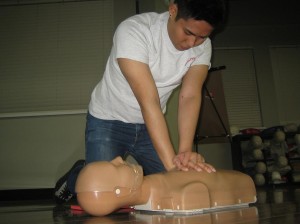Coronary angioplasty or percutaneous coronary intervention is a procedure wherein blocked arteries in the heart are opened. This procedure is done to restore blood flow to the heart and reduce cardiac symptoms such as chest pain.
The material posted on this page on coronary angioplasty and its risks is for learning purposes only. To learn to recognize and manage cardiac and circulatory emergencies take a first aid course with a Canadian training provider near you.
The benefits of coronary angioplasty
Due to aging, the plaques made up of fatty substances can build up inside the arteries. This results in a condition called atherosclerosis that causes the hardening of the arterial wall. Once atherosclerosis occurs, it can lead to a condition called coronary artery disease. The thickened arterial wall will cause the artery to thicken, enlarge and eventually becomes ruptured. As a result of this anatomic changes on the arterial wall, decreased oxygen results, causing the symptoms of pain and angina or chest pain.
If the plaque ruptures, this can cause the formation of blood clots. If a large clot is formed, this can partially or completely block the blood flow through the coronary artery. This is the most common cause of heart attack. Angioplasty can restore the blood flow to the heart. During the procedure, a thin catheter tube with a balloon tip is inserted through a major blood vessel in the affected artery. Once the catheter is in place, the balloon is inflated and compressing the plaque against the artery wall. This restores blood flow to the artery.
What are the risks of the procedure

Coronary angioplasty is a relatively common procedure and complications are less likely to occur. However, serious complications can still occur no matter how careful your doctor is. Complications of angioplasty may include:
- Bleeding and discomfort at the insertion site.
- Damage of blood vessel during the insertion
- Arrythmia
- Kidney damage related to the dye used during the procedure
- Heart attack
- Stroke
The most common complications of coronary angioplasty are restenosis and blood clots. Restenosis can occur if there is too much regrowth of the treated portion of the artery. This usually occurs 6 months after the procedure. Blood clots are highly associated with coronary angioplasty. Once these blood clots become dislodged, this may again obstruct the blood flow of any blood vessel.
First aid training helps in reducing the risks and symptoms
Knowledge and skills of first aid and CPR is very helpful in managing life threatening circumstances that may occur after angioplasty. Abnormal cardiac rhythms may occur, in which case, you should apply CPR immediately whenever the person suffers a sudden heart attack, stroke or loss of breathing. Do not waste the time to report any significant discomfort felt after the angioplasty with the doctor in order to prevent further complications.
Reference:
National Heart, Lung and Blood Institute. What is Coronary Angioplasty? Retrieved on July 7, 2014 from http://www.nhlbi.nih.gov/health/health-topics/topics/angioplasty/.

